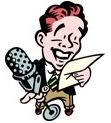Not being an expert on everything health but still wanting to provide the best information and education to you I’ve decided to turn to other sources to share their knowledge and first hand experiences. This first article written by Kathryn Schleich has particular significance to women. You can also read other articles by Kathryn by following the link in the short biography following this article.
_________________________________________________________________________
_________________________________________________________________________
Especially for Women - You're Having A Heart Attack
by Kathryn Schleich
Only when a grave-faced Emergency Room doctor explained to my husband and me I was having a heart attack did the strange symptoms begin to make sense? Because the signs of women experiencing a heart attack are often different than those of men had no idea that was part of what was wrong with me. What I realized is every breath seemed just of reach, the left side of my body ached, and I had lost quite a bit of blood due to the ulcerative colitis which triggered the heart attack.
Some heart attacks are sudden and intense – the classic movie attack where no one doubts what is occurring. But most heart attacks build with slow rising pain and discomfort over a few hours or days rather than a sharp pain bringing one to the ground.
As with men, women’s most common symptoms are chest discomfort in the center of the chest. However, women frequently experience the following as well:
Learn to recogize differences between men and women experiencing heart attacks, but remember this: Even if you are not sure you are not certain it’s a heart attack, have your symptoms checked out by your physician.
- Shortness of breath
- Tightness in the in the center of the chest
- Pain in the jaw area or back.
Some of the more common symptoms in men include:
Related to heart attacks are strokes and people need to familiarize themselves with the signs of stroke which include the following:
- Dizziness
- Breaking out in a cold sweat
- Pain or discomfort in one or both arms
- Light-headedness
Coronary heart disease is the number one cause of death in the United States and a leading cause of permanent disability. This is why it important to reduce your risk factors by knowing both the warning signs and how to respond quickly. In my situation I found myself being rushed into emergency surgery where a large clot was removed from my left artery and a stent permanently implanted.
- Numbness or weakness it the face, arm, leg, of body
- Sudden confusion, speaking, and understanding
- Trouble seeing in one or both eyes
- Trouble speaking, walking, or loss of balance and coordination
- A severe headache with no known cause
Because I was dealing with two separate medical conditions, once the cardiologist repaired my gastro internists could then attempt to repair the ulcerative colitis. At that point my hemoglobin had dropped to 8.2, my potassium was extremely low, and my colon had been severely irritated over the past few weeks. I was placed on powerful steroids to begin the process of healing my colon, ferrous sulfate to repair my weak hemoglobin and a statin drug to keep clots from forming near heart. In all there would be 20 different medications I would take each, some for years to come.
I spent nine days in the Cath Lab of St. Joseph’s Hospital in St. Paul, making excruciating slow progress toward recovery. I started attending Cardio Rehab three days a week, building my strength back up to the four miles I had covered on the treadmill or elliptical at the time of my attack. Gaining your strength back is a difficult process, but if you developed a regular exercise routine, your turn-around time is much faster than for someone who has who has a heart attack or stroke and not and never exercised.
With exercise set small goals you can reach on a daily basis. These can be how far you walk, the number and types of exercises you undertake, monitoring your daily weight especially if you are taking steroids (your appetite can increase significantly), and changes in diet. If you need to lower your blood pressure and cholesterol, approach theses concrete changes by understanding what the numbers mean and their healthy range.
An avid believer in exercise and healthy eating, Kathryn Schleich experienced a serious heart attack in 2009 at the age of 51. Through that experience she has made it her mission to educate heart attack survivors, stroke survivors, and those wishing to maintain or lose weight. Schleich is also a nationally published author and can be contacted at kathrynschlei777@yahoo.com. You may also visit her web site at: www.women-write.com.





0 comments: